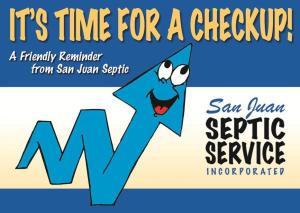Septic System Do’s & Don’ts
To extend the life of your on-site sewage system,
save on maintenance costs and protect water quality,
DO:
1. Inspect your system as required.
In San Juan County, gravity systems must be inspected every three years;
all other systems require an annual inspection. Regular inspections can prevent costly repairs and future failures to your on-site sewage system, which helps to protect the groundwater, marine and freshwater resources, and public health.
In addition, septic tanks generally should be pumped out every three to five years, depending on how regularly the system is used and/or how many people are using it. Inspections may show that you need to pump more or less often. Regular pumping ensures that solids will not flow from the septic tank into
the drainfield. Solids can destroy the drainfield, and pumping will not bring a failed drainfield back to life.
2. Use less water.
Reducing the amount of wastewater entering your on-site sewage system may increase its lifespan. Excessive water use is a main cause of system failure.
- Use water-saving bathroom and kitchen fixtures (faucets, showers, toilets).
- Run and drain appliances, such as dishwashers and washing machines, one at a time.
- Spread laundry over the entire week and avoid partial loads.
- Fix all faucet and toilet leaks promptly.
3. Limit garbage disposal use.
A garbage disposal adds solids and grease to your system, which could lead to drainfield failure.
4. Direct water from downspouts and roofs away from the drainfield.
Additional water from these sources may prevent your drainfield from working properly.
5. Install risers for easier access.
Risers from the tank lids to the soil surface make maintenance easier.
To keep your on-site sewage system (OSS) in proper working order:
Don’t use septic tank additives or “miracle” system cleaners.
Some of these chemicals can actually harm your system by allowing solids to flow into and clog the drainfield. The chemicals can also contaminate ground and surface water.
Don’t dispose of water from hot tubs into your OSS.
Large volumes of water are harmful to the system, and the chlorine can destroy important bacteria in the system. Drain hot tubs onto the ground, away from the drainfield and not into a storm drain.
Don’t flush solid wastes into the system.
These include diapers, cigarette butts, coffee grounds, tampons, condoms, and grease.
Don’t put strong chemicals, such as cleaning products, down the drain.
Household chemicals — such as drain cleaners, paint thinners and floor cleaners — can destroy important bacteria in your septic tank and contaminate ground and surface water. Laundry additives like bleach and fabric softener can also have a negative effect on the bacteria in your tank.
Don’t construct patios, carports or use landscape plastic over the drainfield.
Grass is the best cover for your septic tank and drainfield. Soil compaction and paving prevent oxygen from getting into the soil. This oxygen is needed by bacteria to break down and treat sewage.
Don’t park cars, trucks or heavy machinery on the septic tank and drainfield areas.
The weight can lead to crushed or broken pipes and soil compaction. Compacted soils cannot absorb water from the drainfield. A broken underground pipe can lead to an expensive repair.